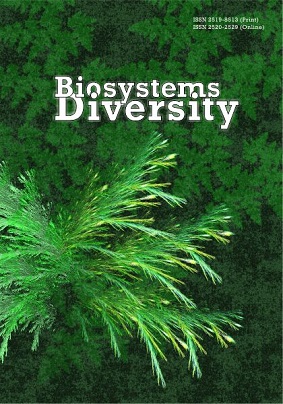Distribution, bioecological peculiarities of staphylinids (Coleoptera, Staphylinidae) in livestock biocenoses of forest-steppe and steppe Ukraine
Distribution, bioecological peculiarities of staphylinids (Coleoptera, Staphylinidae) in livestock biocenoses of forest-steppe and steppe Ukraine
Author(s): A. P. Paliy, A. M. Mashkey, O. I. Kasianenko, R.V. Petrov, L. I. Faly, A. P. PaliiSubject(s): Agriculture, Energy and Environmental Studies, Health and medicine and law, Sociobiology
Published by: Дніпропетровський національний університет імені Олеся Гончара
Keywords: Philonthus; coprophilous species; zoophilous flies; entomophages; biomethod;
Summary/Abstract: As a result of research in the territory of livestock farms, 103 species of predatory Coleoptera were found, including Staphylinidae accounting for 51.4%, Histeridae – 27.3%, Carabidae – 21.3%. A total of 39 species of the Staphylinidae family were identified, belonging to 5 subfamilies: Oxytelinae, Steninae, Staphylininae, Tachyporinae, Aleocharinae. Species composition of staphylinids varied in relation to the types of animal rearing premises. In cowsheds and calf pens species diversity was higher (35 species). To study the peculiarities of feeding in laboratory conditions, we monitored 9 species of Staphylinidae: Philonthus addendus Sharp, Ph. cruentatus(Gmel.), Ph. rectangulus Sharp, Ph. varians(Payk.), Ph. spinipes Sharp, Ph. nitidus F., Creophilus maxillosus(L.), Ontholestes murinus(L.), Oxytelussp. Feeding specialization of imagoes and larvae of different ages was studied. We determined that the mass of food consumed per day is higher than the weight of the beetles. Large species of staphylinids prefer feeding on average-aged larvae of flies and can eat puparia. Peculiarities of the development of coprophilous staphylinids were studied on the example of Ph. spinipes Sharp. During 24 h a female laid 1–3 eggs (in +28°С). Duration of the egg phase depends on the temperature regime (in +20 °С – 4–5, +28 °С – 3–4 days). Cessation of egg laying was observed with decrease in the temperature to +14 °С. The development takes part in three larval stages. Duration of the larva phase at +28 °С was 8–10 days, at +20 °С – 13–14 days. The first moulting was observed on the 2–3th days (in +28 °С) after the larvae emerged from the eggs. At +28 °С the pupa phase lasted 8–10 days. Decrease in temperature prolonged the rate of the development. At +24 °С it practically did not change (9–10 days), at +18 °С – increased to 13–15 days.
Journal: Biosystems Diversity
- Issue Year: 28/2020
- Issue No: 1
- Page Range: 24-28
- Page Count: 5
- Language: English

